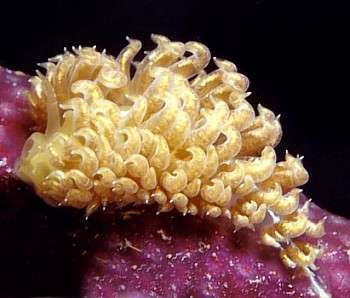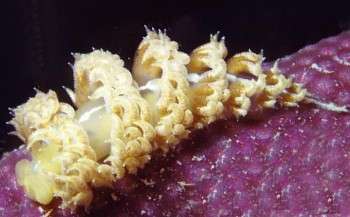

Pauleo jubatus
Millen & Hamann, 1992
Order: NUDIBRANCHIA
Suborder: AEOLIDINA
Family: Glaucidae
DISTRIBUTION
Caribbean
PHOTO
Belize. PHOTO: Anne Dupont.
Pale orange body with a white band down midline from head to posterior end of the foot. Grows to at least 50mm long. The large somewhat flattened cerata are similar to those found in some species of Phyllodesmium, and the cerata break off easily when disturbed like in Phyllodesmium, but they contain a functional cnidosac at the tip, unlike Phyllodesmium.
This species has many similarities to Phyllodesmium. One major difference is the posession of functional cnidosacs.
The cerata show a considerable colour range depending on the colour of the food, ranging from the yellow animals shown here to bluish gray. Found feeding on the gorgonian Plexaurella dichotoma.
Reference:
• Millen, S. V. and J. C. Hamann. (1992) A new genus and species of Facelinidae (Opisthobranchia, Aeolidacea) from the Caribbean Sea. The Veliger 35(3): 205-214.
Rudman, W.B., 1999 (August 24) Pauleo jubatus Millen & Hamann, 1992. [In] Sea Slug Forum. Australian Museum, Sydney. Available from http://www.seaslugforum.net/find/pauljuba
Related messages
Pauleo jubatus from Northern Bahamas [1]
March 9, 2004
From: Marina Poddubetskaia

Dear Bill,
Here is a record of Pauleo jubatus from the Northern Bahamas. Both animals were found during a night dive, on their gorgonian. I moved them on the seaweed because of the current, to have better photos.
Date: February 09, 2004
Location: Bimini Islands, Bahamas, Western Atlantic
Site: Donut Reef
Depth: 10-12m
Length: 35mm, 45mm
Photos: Marina Poddubetskaia - Nembro website
Cordially,
Marina.
nembro@nembro.info


Thanks Marina,
This one of only a few aeolids which eat gorgonians. I have included a few close-ups in a second message [#12401].
Best wishes
Bill Rudman
Pauleo jubatus from northern Bahamas [2]
March 9, 2004
From: Bill Rudman

Here are a few close-ups from Marina Poddubetskaia's recent message about Pauleo jubatus [#12377].
Upper right: shows head and faint rings on the rhinophore club.
Lower left: shows outer side of cerata with opaque white patching.
Lower right: shows inner [lower] side of cerata which lack pigmentation on the skin except near the tip. The brown is the digestive gland duct.
Bimini Islands, Bahamas, Western Atlantic. Site: Donut Reef. Depth: 10-12m. Length: 35mm, 45mm. February 09, 2004. Photos: Marina Poddubetskaia.
Best wishes
Bill Rudman


Rebecca's first Nudibranch
September 4, 2002
From: Paul Young


Dear Bill,
Rebecca, a newly certified diver, recently spotted her first nudibranch in the Southern Bahamas.
Paul.
young@underwater.org
Young, P., 2002 (Sep 4) Rebecca's first Nudibranch. [Message in] Sea Slug Forum. Australian Museum, Sydney. Available from http://www.seaslugforum.net/find/7893Dear Paul,
This is Pauleo jubatus - it could almost be named after you! It is an interesting first find for Rebecca because unusually for an aeolid it feeds on a species of gorgonian. Most of its close relatives are hydroid feeders.
Best wishes,
Bill Rudman
Pauleo jubatus from the Caribbean
January 1, 2001
From: Marli Wakeling

Dear Bill,
This was found on a night dive in West Caicos in the Caribbean. The captain on the boat said it was easy to find nudibranchs, but in many trips I have only found one. It took him the better part of the night dive to find it grazing on a purple sea fan. It was about 1 cm. in length.
Marli
scubamarli@excite.com
Wakeling, M., 2001 (Jan 1) Pauleo jubatus from the Caribbean. [Message in] Sea Slug Forum. Australian Museum, Sydney. Available from http://www.seaslugforum.net/find/3203Thanks Marli,
Bill Rudman
White-speckled aeolid from Belize
August 24, 1999
From: Anne DuPont


Hi Bill,
When I was in Belize [western Caribbean] last month, I photographed several nudibranchs, I wanted to share them with you because they are so cute! I got my identifications from Paul Humann's book. Here is one of them.
Cordially,
Anne
adupont@gate.net
DuPont, A., 1999 (Aug 24) White-speckled aeolid from Belize. [Message in] Sea Slug Forum. Australian Museum, Sydney. Available from http://www.seaslugforum.net/find/1239Thanks Anne,
I'm afraid I'm not familiar with the book you mention, or the nudibranch. It looks quite like Spurilla neapolitana but hopefully someone can help us out with an identity.
Best wishes,
Bill Rudman
Re: Identity of Belize aeolid
August 24, 1999
From: Terry Gosliner
Dear Bill,
The Caribbean aeolid is Pauleo jubatus which feeds on gorgonians. It was described by Sandra Millen and Jeff Hamann in 1992. The reference is:
Millen, S. V. and J. C. Hamann. 1992 A new genus and species of Facelinidae (Opisthobranchia, Aeolidacea) from the Caribbean Sea. Veliger 35(3): 205-214. Glad to see you into the second millenium of messages. May the force continue to be with you.
Terry
tgosline@calacademy.org
Gosliner, T., 1999 (Aug 24) Re: Identity of Belize aeolid. [Message in] Sea Slug Forum. Australian Museum, Sydney. Available from http://www.seaslugforum.net/find/1243Thanks Terry,
Now I've looked at Veliger again, I remember reading that paper with interest. It obviously has much in common with Phyllodesmium, but the functional cnidosacs are definitely different. Most octocoral-feeding nudibranchs feed on those with symbiotic zooxanthellae, because on the whole, those species have few nematocysts, or the nematocysts are not a problem for the nudibranch. I wonder if Pauleo jubatus's food, Plexaurella has symbiotic zooxanthellae and/or functional nematocysts.
Best wishes,
Bill Rudman.
